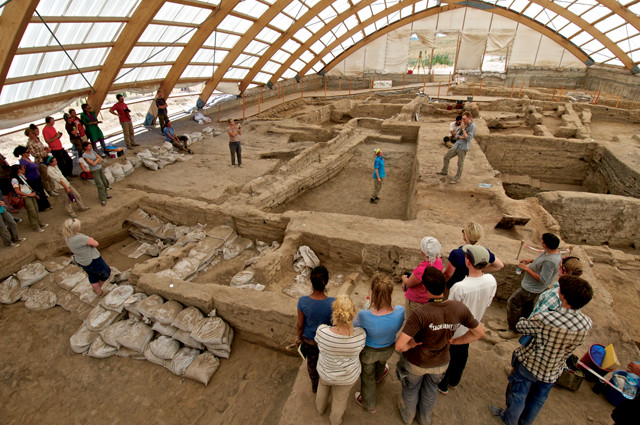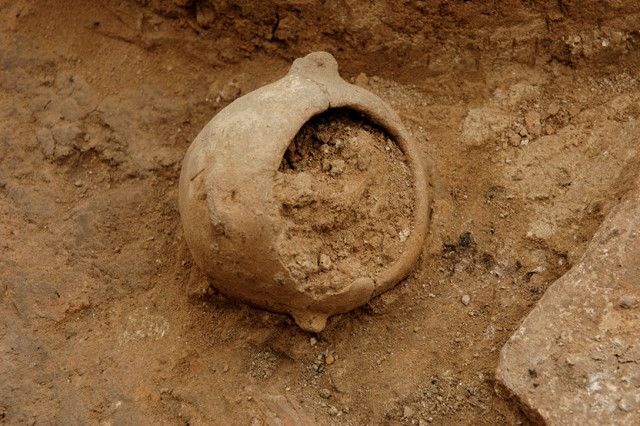
by Mary Caperton Morton Thursday, November 8, 2018

Çatalhöyük, in what is now central Turkey, was once a thriving Neolithic settlement, home to as many as 10,000 people. Credit: Çatalhöyük Research Project.
About 8,200 years ago, right around the time that animals such as cows and sheep were first being domesticated in the Near East for meat and milk, the planet underwent a cooling event that lasted about 160 years. How this cold snap, known as the 8.2-kiloyear event, affected early farmers has long been a mystery, as archaeological evidence from the period of the cooler and drier climate has been scant. But new research investigating fatty residues preserved on scraps of pottery found at the UNESCO World Heritage site of Çatalhöyük in Turkey is offering some clues.
Between 9,050 and 7,150 years ago, Çatalhöyük was a thriving Neolithic and Early Chalcolithic (Copper Age) settlement, home to as many as 10,000 people, including early farmers who grew wheat, barley and peas and raised goats, sheep and cattle. Çatalhöyük has been excavated since the 1960s and is one of the most thoroughly studied and well-dated archaeological sites in the Near East, but there’s still more to find. Recent excavations uncovered a wealth of clay potsherds dating from 8,300 to 7,900 years ago, spanning the 8.2-kiloyear climate event.
Many of the sherds are enriched with fatty residues left behind from cooking meat in the vessels. “In the past, we’ve used animal fats preserved on potsherds to study various aspects of animal exploitation,” such as the spread of meat and dairy farming, says Richard Evershed, a biogeochemist at the University of Bristol in England and a co-author of the new study, published in Proceedings of the National Academy of Sciences. Since this site is so well-dated, he says, the team wondered whether the fats could act as a proxy for climatic changes that affected this settlement about 8,200 years ago.
The team, led by biochemist Mélanie Roffet-Salque, also at the University of Bristol, used gas chromatography coupled with isotope-ratio mass spectrometry to determine the isotopic ratios of hydrogen preserved in the animal fats within the potsherds. They found that the sherds dating to the cold period had elevated ratios of deuterium to hydrogen isotopes. Rainfall is known to contain more deuterium, a heavy form of hydrogen, during times of low precipitation; this signature is then transferred to plants and grazing animals. Climate models have shown that the 8.2-kiloyear event, likely triggered when massive glacial lakes in North America began pouring into the Atlantic Ocean, leading to widespread cooling, may have also been a dry time for much of the Northern Hemisphere.
The new study presents the first clear archaeological evidence that humans may have been affected by the 8.2-kiloyear event, says Alexandra Bayliss, an environmental scientist at the University of Stirling in England, who was not involved in the new research. “We know from ice-core records that this climate event definitely affected the Arctic, but the holy grail question is whether it impacted humans.”

Researchers tested fatty residues on pottery found at Çatalhöyük and found evidence of a cold snap 8,200 years ago. Credit: Çatalhöyük Research Project.
Other aspects of the team’s research at Çatalhöyük indicate a shift from cattle to more drought-hardy goats around the time of the cooling event, as well as subtle changes in the settlement’s architecture, with single-family households replacing the older large communal dwellings. Clearly there were “adaptations taking place that may reflect changing circumstances,” Evershed says. However, “the archaeological record can be very difficult to interpret,” he says, and the team can’t say for sure whether the people experienced hardship during this time period.
Studying deuterium-hydrogen ratios in preserved animal fats may prove useful at other archaeological sites affected by shifting climatic patterns, Bayliss notes. “As long as you’ve got pottery and you are able to establish a chronology, you could use this technique to track climate signals for other climate events such as the Younger Dryas,” a cold snap that persisted over the Northern Hemisphere between 12,900 and 11,700 years ago.
“This tool has a lot of potential for using biomolecules preserved at ancient sites to reconstruct paleoclimate trends,” Evershed says. “This study is just the start.”
© 2008-2021. All rights reserved. Any copying, redistribution or retransmission of any of the contents of this service without the expressed written permission of the American Geosciences Institute is expressly prohibited. Click here for all copyright requests.